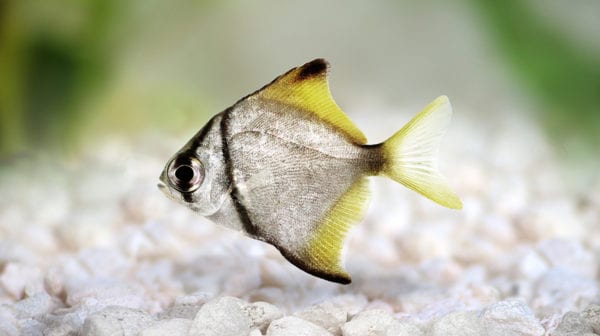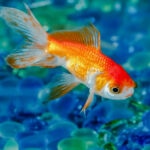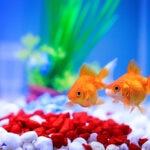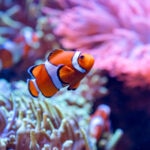Creating A Brackish Habitat Fish Aquarium

Photo by Chewy
It happens to just about all of us. We’ve been in the aquarium hobby for several years, keeping a variety of fish from barbs to catfish to cichlids, but we still yearn for something different. We may try our hand at breeding fish or growing live plants, or go the marine route. However, probably the most underappreciated and misunderstood of aquarium specialties is the brackish aquarium.
Brackish tanks are a good way to explore the salty side of the hobby without setting up a marine or reef tank. Unlike true saltwater systems, brackish aquariums do not require the considerable cost, complexity and time commitment required to be successful – but they still offer something definitely different than freshwater. Some of the most interesting fish in the hobby are brackish species, and the aquarist of today has many brackish choices.
Problems usually occur because of a lack of education on brackish water and its specialized livestock. Reading this article should help you be successful with a brackish aquarium.
What is “Brackish?”
It’s not quite saltwater, but it’s definitely not freshwater. Brackish waters occur all over the world where inland freshwater streams and springs meet the ocean, creating estuary biotopes. The lower part of the Hudson River that separates New York and New Jersey, for example, is a giant brackish biotope. This is also true for many of the small canals in sub-tropical Florida. Unique plants and animals have evolved in these habitats to capitalize on the scarce food sources and unique protection in these ecosystems.
But what exactly do we mean by the term “brackish”? Technically, the word is an adjective to describe any water that is “salty” or “briny” but not the full salinity of seawater. However, just adding salt to your tank (as many old timers swear by) is not enough.
An operational definition is then in order for aquarium purposes – and this is where the problem lies. Hobbyists express little agreement in what makes water brackish. A little research into natural brackish environments and freshwater fish tolerances may help clear this up and provide you with the most important recommendation for setting up a brackish tank: target salinity levels.
The Salinity of Brackish Water
The world’s marine waters have a salinity between 32 and 35 parts per thousand. Brackish water, by definition, must be lower than the lowest value of this range.
Many freshwater aquarium species can withstand (or benefit from, according to some) a certain level of salinity in their tank water. My own experience, as well as accepted practices in the commercial and amateur aquarium hobby over the past 100 years, indicates that a maximum of 2 tablespoons per 10 gallons is tolerated by many freshwater aquarium fish. North of this, then, is probably the lower part of the brackish range for practical purposes.
Now, we can set a safe and appropriate target range for our brackish aquarium. Calculating the salinity of water is done by measuring specific gravity (SG) with a hydrometer, or alternatively, conductivity via a meter. Both of these methods are temperature dependent – readings vary with the warmth of the water. I will be stating salinity as “SG” because this is the unit of measurement quoted in all reference sources, and the one measured by most readily available and affordable testing equipment.
For practical purposes, brackish aquarium water should range between 1.002 to 1.022 SG at a temperature of 77 degrees Fahrenheit. Most brackish aquarium fish can tolerate this range. A 50/50 mix of fresh and marine water would provide a salinity of 1.012 SG – a happy medium for a general brackish aquarium. Temperature is critical when measuring. The noted value of 77 degrees is the temperature to which most commercial hydrometers are calibrated. Also, the brackish fish covered in this article do best in the upper aquarium temperature range, with 77 degrees a good lower target.
If you want to provide the best care for your brackish fish, however, I recommend matching the salinity level to the type of brackish habitat you are trying to re-create or the type of brackish fish you want to maintain. Some brackish fish start their lives out in freshwater and eventually make their way “down the estuary” to become fully marine fish as adults.
Equipment for the Brackish Aquarium
As you may have surmised, the most important piece of equipment when setting up a brackish aquarium is a good hydrometer to measure SG. Shop around various stores, ask marine hobbyists and search for reviews on the Internet to select the most reliable and serviceable model. All hobby hydrometers are designed for marine aquarium use, so some do not adequately measure lower salinity levels. Check the scale to make sure it can cover the brackish range. (Many brackish aquarium hobbyists like myself swear by beer hydrometers sold at home brewing stores.)
The next essential item is salt. Most brackish hobbyists use a high-quality marine salt mix to best replicate biotopic water conditions. Aquarium salt is another option that has been reported with good success. Just avoid household table salt because of the excess silicates and iodide. Do not add salt directly to the fish aquarium. Always pre-dissolve it first to avoid burning and shocking your fish and plants.
In terms of tank size, any aquarium will suffice, given that there are brackish fish suitable for everything from micro-cube tanks to 100-gallon tanks or larger. Regardless of tank size, you will need a good-quality heater to maintain the necessary warm temperatures that most brackish fish crave. Mechanical filtration via a power filter is good to circulate the warmth. Make sure there are biological and carbon components in your filter to compensate for the absence of vegetative filtration (more on this later). Never skimp on heaters or fish tank filters. If they fail, the results can be disastrous.
Brackish biotopes tend to be sandy or muddy, so fine gravel or my favorite, swimming pool filter sand, works well. This latter substrate is pre-washed, cheap and does not pack down like playground sand. And it looks great, too! Water parameters of the brackish aquarium should target a DH of 9 to 19 and a pH of 7.5 to 9.5. Marine salts will establish these conditions, and finely crushed coral or shells mixed into the sand or in a nylon bag in your filter can further bring water parameters up to range, if necessary. This is a more natural and less stressful method than using chemical additives.
Because nearly all aquatic plants cannot survive salt, it is not surprising to learn that brackish habitats are often somewhat sparse. There are many realistic natural and plastic driftwoods on the market, with some resembling mangrove or tree roots. Many brackish fish naturally swim among rootlike structures. Algae growth should be encouraged, as many of these fish are algae eaters.
Inhabitants for the Brackish Aquarium
There are a myriad of fish choices for the brackish aquarium, especially at the very lowest salinity ranges tolerated by most freshwater fish (1.001 SG). For this article, however, I will only highlight “true” brackish fish. The more important decision is matching your available tank size with the proper fish. Brackish fish in general – due to size, schooling, territoriality and aggression – seem to require more space than freshwater tropicals. And remember that these are very alkaline tanks with little vegetative filtration. Ammonia can be problematic even in small concentrations, so stock lightly.
Big Fish (36-Inch Tanks)
Monos/fingerfish
(Monodactylus spp.)
Temperature and salinity: 77 to 82 degrees Fahrenheit, 1.005 to 1.020 SG (increased over time). These beautiful disk-shaped schoolers grow to more than 9 inches in diameter. Keep them in a school of at least three.
Scats
(Selenotoca, Scatophagus spp.)
Temperature and salinity: 77 to 82 degrees, 1.005 to 1.020 SG (raised over time). They do well with monos and prefer being in a small shoal (at least three). They have a voracious appetite, especially for vegetation.
Archerfish
(Toxotes spp.)
Temperature and salinity: 77 to 86 degrees, 1.005 to 1.020 SG. The spitting ability of the archerfish is legendary. If live flies in the fish room are not your bag, try pressing fish food against the glass above the surface of the water. Adults can reach 1 foot in length. Keep them as single specimens.
Spotted green pufferfish
(Tetraodon fluvialitis)
Temperature and salinity: 75 to 82 degrees, 1.005 to 1.015 SG. Puffers are aggressive fish best kept as solitary animals. They need shellfish in their diet, and they are a great way to get rid of unwanted snails. Note that puffers are a diverse family of fish – many are not brackish and are often mislabeled as such in shops. So, if you see a species you’re interested in purchasing, do some research before buying it.
Orange chromide cichlid
(Etropulus maculatus)
Temperature and salinity: 75 to 82 degrees, 1.001 to 1.012 SG. This is an ancient cichlid whose parenting is a joy to witness. Provide a small flowerpot turned on its side for spawning or a sheltered rocky area.
Sailfin mollies
(Poecilia latipinnia, velifera and hybrids)
Temperature and salinity: 77 to 86 degrees, 1.000 to 1.020 SG. Retail varieties originated from Floridian and Yucatan coastal races, and do well in saltwater. In nature, some populations are found living in the sea. Not a beginner’s fish, mollies require plenty of room and more vegetable matter than most hobbyists realize. Displaying males are truly spectacular.
Wrestling halfbeak
(Dermogenys pusilla)
Temperature and salinity: 70 to 80 degrees, 1.001 to 1.012 SG. Halfbeaks comprise a large family of fish, but this livebearing species is the most common. Although these fish are categorized as medium-sized, long tanks (30 inches or longer) with floating plants are recommended for more than a pair. This species is a top-dwelling but peaceful oddball.
Small Fish (16-Inch Tanks)
Limias
(Limia caymanesis, vittata and nigrofasciatum)
Temperature and salinity: 75 to 82 degrees, 1.000 to 1.012 SG. These are ancestral Poecilid livebearers and do better with some salt, as is found in most of their habitats. Look for them at fish club auctions.
Black mollies
(Poecilia sphenops hybrids)
Temperature and salinity: 77 to 85 degrees, 1.001 to 1.020 SG. These fish generally do best with salt, due to their hybridization with Floridian species. Warmth is critical for this touchy pet shop favorite.
Heterandria formosa
Temperature and salinity: 60 to 80 degrees, 1.000 to 1.015. The smallest livebearing fish and seventh smallest fish in the world, these native cuties prefer weedy areas. Females give birth every few days to single fry. They are perfect for “microtanks.”
Bumblebee gobies
(Brachygobius sp.)
Temperature and salinity: 77 to 86 degrees, 1.005 to 1.012 SG. This is a great combo with halfbeaks for an Asian brackish tank. Bumblebee gobies are bottom dwellers that are best in a small shoal to spread out aggression among themselves. They require live or frozen foods and warmth. They are good for mini brackish tanks of 2 1/2 gallons.
Plants
Plants and salt don’t mix, with the exception of algae. At the lower salinity range (1.002), you can attempt some hardwater plants that may manage to live. These include the Asian Hygrophila, African Anubias, America’s Anacharis and wide-ranging Vallisnerias. All demand light of at least 1.5 watts per gallon – more for deep tanks.
Only one plant can survive and thrive in higher salinity levels: the mangrove. These brackish swamp trees can secrete salt and retain water. For aquarists, the problem with mangroves is that they are bog plants – their stems and roots are underwater, while their branches and leaves are above the water line. So, they are best for an open tank with a hanging light or window, or a very deep tank that is half filled with water. Aquarium magazines may advertise mangrove saplings for sale in their classified sections.
I have had better success with two popular aquarium plants for slightly brackish aquariums. Both provide an alternative for additional vegetative filtration and aquascaping. Java fern (Microsorum pteropus) is a low-light favorite among fishkeepers. An epiphytic fern, it should never be “planted” but simply placed on top of the substrate, or tied to wood or rocks with thread or rubber bands. It grows particularly well on driftwood, and is often found near saltwater sprays in its native Indonesia. Tropical hornwort (Ceratophyllum submersum) can also survive a brackish environment if drip acclimated. Like Java fern, it does not possess roots. Simply float it, or hold it down with a stone, and it will branch and grow through the aquarium.
So, the next time you ask yourself what fish you should try next, consider a brackish aquarium.
Posted by: Chewy Editorial
Featured Image: Mirko Rosenau/Shutterstock.com



